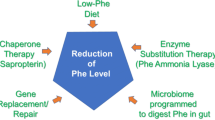Abstract
Early differential diagnosis between PKU and prolonged Hyperphenylalaninemia is an important but difficult problem. No clear-cut differences between the two conditions occur with respect to blood level, results of the usual 5 hrs loading test and the urinary excretion of metabolites. The initial blood levels and the degree of blood level increase in the newborn were analysed in 34 cases of PKU and 15 cases of Hyperphenylalaninemia with a view to possible differentiation. In 16 of these PKU cases and 1 PKU sibling in addition and in 14 of the Hyperphenylalaninemia cases and in 2 additional siblings the loading test was done with blood sampling up to 48 hrs (Blaskovits).
The loading tests show that in PKU there is no difference between the blood levels at 5, 24 and 48 hrs after loading, and no difference between infants and children above 1 year of age. On the other hand in Hyperphenylalaninemia there is an important shift from high to low blood levels during the 48 hrs. There is also a difference between the two age groups in that the greatest decrease in the blood level occurs some 20 hrs earlier in the children than in the infants. This means that in the infants at 5 hrs there is a complete overlap of results in PKU and Hyperphenylalaninemia whereas at 48 hrs the overlap is only very small. There was 1 (possibly 2) misleading results in 19 infants.
Evaluation of the initial blood levels and the degree of increase resulted in 1 completely and 2 partially misleading results in 49 newborn infants: 1 PKU had a low initial level and a gradual increase as is characteristic for Hyperphenylalaninemia and 2 PKU's had high initial values as one would expect but then showed a gradual instead of a steep increase thus “changing over” to the Hyperphenylalaninemia group. For evaluation of the initial blood level the sample should not be taken before the fourth day of life.
A combination of the two methods seems to be the best way at present to differentiate between PKU and Hyperphenylalaninemia. There were 2 false results in 30 cases using the 48 hrs loading test. In the evaluation of the initial blood level and the degree of increase there was 1 completely misleading result and in 1 additional case the initial value was in the expected range but the increase was misleading, i.e. a partially misleading result. The important point is that the erroneous results with the two methods did not occur in the same children. Thus if the two methods correlated with each other there were no diagnostic errors in 26 newborn infants (13 PKU's and 13 Hyperphenylalaninemics). If the results of the 2 tests do not agree a definitive diagnosis should not be made in view of the possible therapeutic consequences.
Zusammenfassung
Die frühzeitige Unterscheidung zwischen PKU und Hyperphenylalaninämie mit lang anhaltend über 8 mg/100ml erhöhten Werten ist ein wichtiges, aber schwieriges Problem. Hinsichtlich Blutspiegelhöhe und “üblicher” (5 Std) Belastungsprobe bestehen bei Säuglingen zwischen den beiden Zuständen keine klar abgrenzbaren Unterschiede, ebenso bestehen keine gesetzmäßigen Unterschiede bezüglich Ausscheidung von Metaboliten im Harn. Auf der Suche nach Unterscheidungsmerkmalen wurde der Initialblutspiegel und der Blutspiegelanstieg bei 34 Neugeborenen verglichen. Bei 16 dieser PKU-Fälle sowie 1 kranken PKU-Geschwister und bei 14 dieser Fälle von Hyperphenylalaninämie sowie 2 affizierten Geschwistern wurden Belastungsproben mit Verfolgung des Blutspiegels über 48 Std (Blaskovits) ausgeführt.
Die Belastungsproben zeigen bei PKU keinen Abfall nach 5, 24 und 48 Std und keine Unterschiede zwischen Säuglingen und mehr als 1 Jahr alten Kindern.
Im Gegensatz dazu besteht bei Hyperphenylalaninämie in diesem Zeitraum eine deutliche Abnahme der Blutspiegel. Es besteht auch ein ausgesprochener Unterschied zwischen den beiden Altersstufen, indem der wesentliche Blutspiegelabfall bei Kindern über 1 Jahr etwa 20 Std früher eintritt als bei Säuglingen. Dies führt bei Säuglingen von einer vollständigen Überlappung der Werte für PKU und Hyperphenylalaninämie nach 5 Std zu einer nur geringen nach 48 Std — 1, vielleicht 2 irreführende Ergebnisse unter 19 Säuglingen.
Die Analyse von Initialblutspiegel und Blutspiegelanstieg ergab 1 ganz und 2 teilweise irreführende Ergebnisse unter 49 Neugeborenen. Nur 1 PKU-Neugeborenes hatte einen niederen Initialwert und einen flachen Anstieg, wie es für Hyperphenylalaninämie charakteristisch ist, und 2 PKU-Neugeborene hatten hohe Initialwerte, wie sie sollten, aber flache Anstiege, ihre Kurven wechselten in die Hyperphenylalaniämie-Gruppe. Bei differentialdiagnostischer Auswertung der Initialblutspiegel sollte die Blutabnahme nicht vor dem 4. Lebenstag erfolgen.
Die Kombination beider Methoden scheint der derzeit beste Weg zur frühen Differentialdiagnose zwischen PKU und Hyperphenylalaninämie. Unter 30 auf beide Arten untersuchten Säuglingen wiesen 2 ein “falsches” Ergebnis in der 48 Std-Belastung und 1 ein “falsches” Ergebnis in der “Initialblutspiegel-Anstieg-Auswertung” auf; bei 1 weiteren Neugeborenen war der Initialblutspiegel “richtig”, aber der Anstieg “falsch”, das Ergebnis also partiell “falsch”. Wesentlich scheint, daß die irreführenden Ergebnisse beider Methoden nicht dieselben Kinder betrafen. Bei 26 Neugeborenen (13 PKU und 13 Hyperphenylalaninämie), deren Ergebnisse in beiden Methoden im selben Sinn sprachen, trat kein Fehlurteil auf. Diskordante Ergebnisse der beiden Beurteilungsverfahren sollen vor der endgültigen Zuordnung eines Falles zur einen oder anderen Gruppe — und eventuellen therapeutischen Konsequenzen — warnen.
Similar content being viewed by others
References
Bickel, H.: Phenylalaninaemia or classical phenylketonuria (PKU)? Neuropädiatrie 1, 379–382 (1970).
Blaskovics, M. E.: Personal communication.
Guthrie, R., Susi, A.: A simple phenylalanine method for detecting phenylketonuria in large populations of newborn infants. Pediatrics 32, 338–343 (1963).
Menkes, J. H., Holtzman, N. A.: Neonatal hyperphenylalaninemia: a differential diagnosis. Neuropädiatrie 1, 434–446 (1970).
Thalhammer, O., Scheibenreiter, S., Biedl, E.: Über das österreichische Programm zur Früherfassung angeborener Stoffwechselanomalien. Wien. klin. Wschr. 82, 1–6 (1970).
Author information
Authors and Affiliations
Rights and permissions
About this article
Cite this article
Scheibenreiter, S., Thalhammer, O. Hyperphenylalaninemia or phenylketonuria (PKU)?. Z. Kinder-Heilk. 112, 153–162 (1972). https://doi.org/10.1007/BF00443502
Received:
Issue Date:
DOI: https://doi.org/10.1007/BF00443502




